2014 Redband Fundraiser Update
Taylor McCroskey - 03/10/15
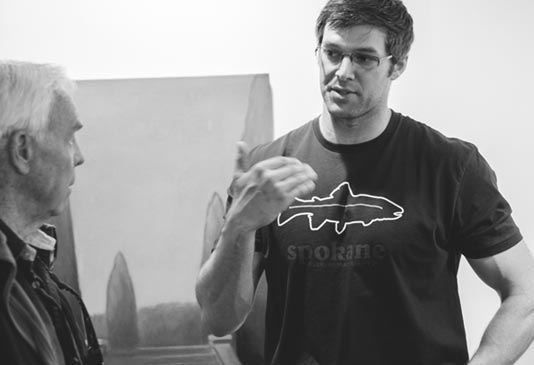 Taylor McCroskey - EWU Grad Student
Taylor McCroskey - EWU Grad Student
Working Towards a Healthier Fishery
Last April we held our first Spokane River Benefit featuring the International Fly Fishing Film Festival. Our first year was a great success with 350 in attendance and approximately $7400 raised for redband trout research studies. In partnership with Spokane Falls Trout Unlimited and Taylor McCroskey, a fellow fly fisher and Fisheries Management grad student at EWU, we had determined that the money would be best used in studies tracking redband movement on the upper Spokane River. This data could then be used in future projects related to restoring the declining redband populations.
Since the 2014 event we have been in contact with Taylor and Bill Abrahamse (Spokane Falls Trout Unlmited chapter president) and have identified a project that the funds would be even better used for. Taylor was kind enough to give us a brief write-up on the new study that his efforts will be shifted to.
A brief overview on the redband trout populations:
The population of redband trout (Oncorhynchus mykiss var. gairdneri) in the upper Spokane River (Figure 1) has been in decline for a number of years. In 1980, the population was estimated to be between 7,200 to 13,200 salmonids by Bailey and Slates (1982). In 1991, Davis and Horner estimated 4,000 rainbow trout and O'Connor and McLellan estimated that there were only 1,149 redband trout in the upper Spokane River in 2007. Abundance estimates in the Stateline to Harvard Road reach in 2009 was 96% lower, according to McLeallan and King, compared to the 1990 estimate done by Davis and Horner.
A variety of factors have been hypothesized as to the source of the decline of the redband trout population in the upper Spokane River. Some of these factors include: exposure to pollutants, reduction in discharge during juvenile emergence, reduction in stream habitat, reduction in productivity, and non-native predators. These factors have all impacted the native population to a point that preserving and protecting these fish is at the forefront of organizations like Washington Department of Fish and Wildlife (WDFW), Trout Unlimited, and local business like the Silver Bow Fly Shop.
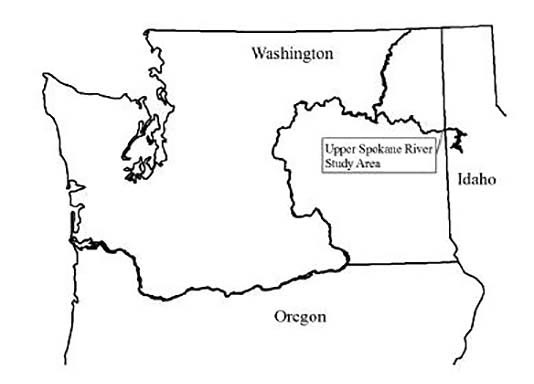
- Figure 1
WDFW and Avista work together to improve spawning habitat:
WDFW, as well as the Avista Corporation, has identified the Starr Road complex (Figure 2) as one of the major spawning beds for redband trout in the upper Spokane River. In late August, 2015, WDFW plans to install five large wooded debris (LWD; Figure 3) structures into the upper Spokane River, near Starr Road. LWD creates spawning habitat, provides protection from predation and high flows, and increases nutrient retention. These structures are designed by WDFW engineers and will be placed in the river by environmental contractors. During high flow months, all five structures will be completely inundated. However, during low flow months, only two of the five structures will be partially inundated. The structures will be constructed of two to three logs, depending on the location within the river channel, with a rootwad in the center of the structures.
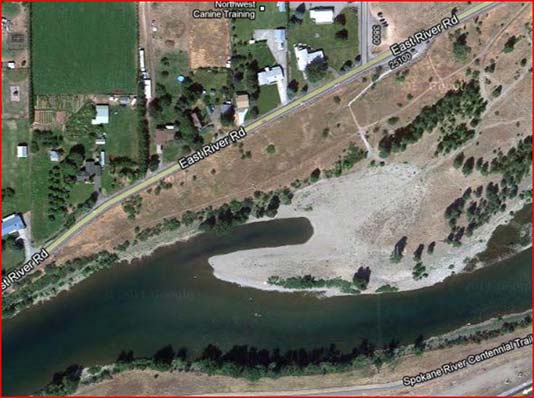
- Figure 2
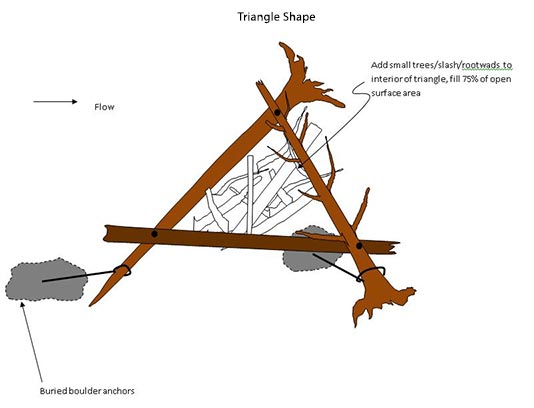
- Figure 3
A baseline study (Figure 4) will be conducted before the structures are placed in the river. This study will provide essential data to determine if the structures have any impact on the redband population, specifically the juvenile population. The survey will be conducted from June through August, with sampling occurring four times a month. The study will use snorkel surveys (Figure 5) to obtain data about the abundance of juvenile redband trout and smallmouth bass (Micropterus dolemieu) in the Starr Road complex. The data will be used to determine the differences between the abundance of juvenile redband trout and smallmouth bass in the Starr Road complex compared to two reference sites.
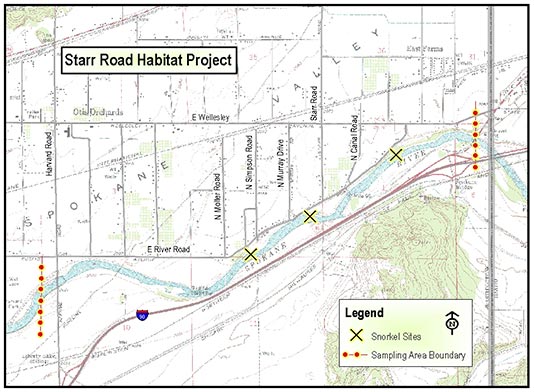
- Figure 4
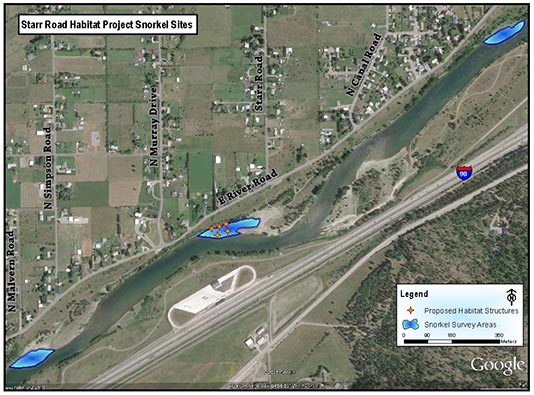
- Figure 5
Another goal of the study is to determine the predation rate of smallmouth bass on juvenile redband trout in the reach from the Stateline, between Washington and Idaho, to the Harvard Bridge Road. Electroshocking, as well as angling surveys, will be conducted to obtain diet samples from smallmouth bass. Data obtained from the smallmouth bass diet samples then allow for calculations of predation rates on juvenile redband trout, age at which smallmouth bass are predaceous, and diet composition.
This study will provide a baseline of information to allow for further assessment of the Starr Road habitat project. This information will allow fisheries managers to determine the effects of the structures, if any. It will also allow fisheries managers a better understanding of the dynamics of the predation rates on juvenile redband trout by smallmouth bass. If these structures do provide juvenile fish refuge and increase the number of juvenile redband trout in the upper river, this project will be considered a success. WDFW will use this study as a baseline to consider putting other structures in throughout the river to increase rearing habitat for redband trout. Ensuring redband trout populations exist for future generations is a very important goal.
Taylor McCroskey - EWU Grad Student
A new focus will be determining how spawning structures will work:
Learn more about our 2015 Spokane River Benefit - https://www.silverbowflyshop.com/blog/if4-international-film-festival-spokane-river-access-fundraiser
